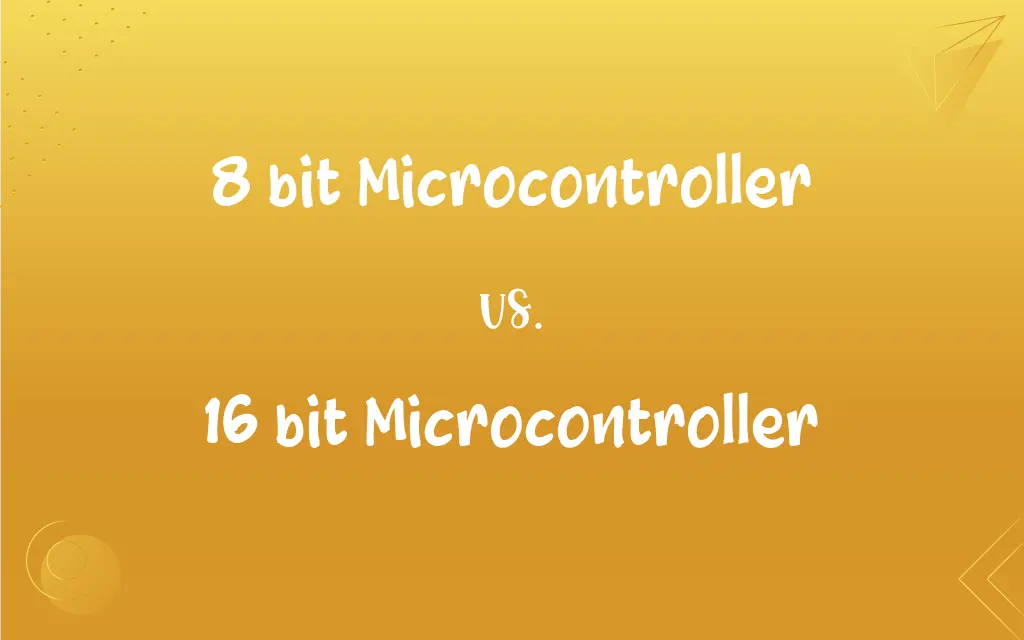8 bit Microcontroller vs. 16 bit Microcontroller: What's the Difference?
Edited by Aimie Carlson || By Harlon Moss || Updated on October 7, 2023
8-bit microcontrollers process 8 bits of data per clock cycle, suitable for simpler applications. 16-bit microcontrollers, with a wider data path, handle more complex tasks, providing more processing power and precision.

Key Differences
The 8-bit microcontroller refers to a microcontroller that processes 8 bits of data at a time. It often comes with simpler architectures and is typically used in applications where low power consumption and cost-effectiveness are critical. The 16-bit microcontroller, on the other hand, can process 16 bits of data at once, offering more processing power and is suitable for applications that require handling more complex operations and data. The increased bit size often translates into higher computational power and precision.
While 8-bit microcontrollers are popular in various consumer devices and simpler industrial applications due to their ease of use and low cost, 16-bit microcontrollers find their place in applications that need more computational strength and larger memory space. 8-bit variants are usually preferred for tasks that require less computational work, while 16-bit types are chosen for applications that need to handle complex algorithms or manage large data sets. The specific choice between an 8-bit and a 16-bit microcontroller may depend on factors like computational needs, budget, and power consumption.
Regarding power consumption, 8-bit microcontrollers are often seen in battery-operated devices due to their ability to perform adequately while consuming less power. 16-bit microcontrollers might be found in situations where power is less of a concern, and more processing capability is needed. 8-bit microcontrollers might have limitations when it comes to performing tasks that require handling large data or higher speed due to their constrained data path width. Conversely, 16-bit microcontrollers, with their broader data path, are adept at managing applications that need higher data throughput and faster processing speeds.
In terms of application development, 8-bit microcontrollers tend to provide a more straightforward development environment, often being more forgiving and accessible for beginners or for applications with simple control requirements. 16-bit microcontrollers may offer a steeper learning curve with their advanced capabilities and larger variety of peripherals, making them potent for professional developers working on intricate, data-rich applications. The 8-bit microcontroller might be chosen for simplicity and ease of development, while the 16-bit variant may be selected for applications that need advanced functionalities and precision.
Memory and peripherals availability is another differentiating factor between 8-bit and 16-bit microcontrollers. 8-bit microcontrollers often come with limited memory and fewer peripherals due to their simplified design and targeted application fields. In contrast, 16-bit microcontrollers tend to support larger memory sizes and may come with a wide variety of advanced peripherals, such as sophisticated timers, communication ports, and specialized input/output pins, suitable for more complex, resource-demanding applications. Both 8-bit and 16-bit microcontrollers come with their own sets of advantages and limitations, catering to different segments of applications in the electronics world.
ADVERTISEMENT
Comparison Chart
Data Processing
Processes 8 bits of data per cycle.
Processes 16 bits of data per cycle.
Complexity
Suitable for simpler, less data-intensive applications.
Apt for more complex and data-intensive applications.
Power Consumption
Typically consumes less power.
Might consume more power due to enhanced processing.
Cost
Generally more cost-effective.
Might be more expensive due to advanced capabilities.
Use-cases
Ideal for basic control systems and consumer devices.
Used in advanced robotics and intricate control systems.
ADVERTISEMENT
8 bit Microcontroller and 16 bit Microcontroller Definitions
8 bit Microcontroller
They cater to applications requiring straightforward, minimal computational capabilities.
For basic LED control, an 8-bit microcontroller suffices.
16 bit Microcontroller
This type is typically chosen for applications demanding significant computational power and precision.
The 16-bit microcontroller is fundamental in certain advanced communication systems due to its enhanced data handling.
8 bit Microcontroller
8-bit microcontrollers are often utilized for their low power consumption.
Designers might choose an 8-bit microcontroller to enhance battery life in portable devices.
16 bit Microcontroller
It offers a wider data path, allowing for more data to be processed simultaneously.
To manage high-fidelity audio processing, a 16-bit microcontroller is often preferred.
8 bit Microcontroller
Despite technological advancements, 8-bit microcontrollers remain popular in several industries.
The 8-bit microcontroller continues to dominate the market for basic embedded systems due to its affordability and simplicity.
16 bit Microcontroller
Suitable for varied applications, encompassing complex tasks requiring enhanced processing power.
Automotive engineers frequently utilize 16-bit microcontrollers to manage multiple functions concurrently.
8 bit Microcontroller
An 8-bit microcontroller processes 8 bits of data in a single processing cycle.
The 8-bit microcontroller is ideal for managing simple electronic devices.
16 bit Microcontroller
A 16-bit microcontroller can process larger data, offering improved computational capabilities.
Complex automation systems often leverage the advanced computing capabilities of a 16-bit microcontroller.
8 bit Microcontroller
8-bit variants tend to be cost-effective solutions for basic control tasks.
Companies may opt for the 8-bit microcontroller in mass-produced toys to minimize production costs.
16 bit Microcontroller
This type ensures higher precision in data processing and control.
The 16-bit microcontroller, due to its precision, is pivotal in sophisticated medical devices.
FAQs
Does an 8-bit microcontroller consume less power than a 16-bit microcontroller?
Typically, yes; 8-bit microcontrollers often consume less power due to their simpler processing capabilities, making them suitable for battery-powered devices.
What is a practical application of an 8-bit microcontroller?
8-bit microcontrollers are often utilized in simple appliances like microwave ovens due to their basic control needs and cost-effectiveness.
What factors might influence the choice between 8-bit and 16-bit microcontrollers for a project?
Considerations may include the complexity of the task, power consumption, budget, and specific technical requirements of the application.
In what scenarios might the higher precision of a 16-bit microcontroller be necessary?
In applications like medical devices or precision machinery, where data accuracy and processing capabilities are crucial, a 16-bit microcontroller might be preferred.
Are 16-bit microcontrollers inherently more robust than 8-bit microcontrollers?
Not necessarily. Robustness depends on various factors, including build quality and environmental tolerance, which can be independent of bit-size.
How do the internal architectures of 8-bit and 16-bit microcontrollers typically differ?
Beyond data path width, differences might include memory size, processing speed, and available peripherals, impacting their respective application domains.
Can a 16-bit microcontroller be used for basic applications suitable for 8-bit microcontrollers?
While possible, it might be economically inefficient due to the generally higher cost and complexity of 16-bit microcontrollers.
Are 8-bit microcontrollers becoming obsolete with advancements in technology?
Not necessarily. 8-bit microcontrollers still find widespread use in applications where complexity and high processing power are not critical, primarily due to their cost-effectiveness and power efficiency.
How does the data path width impact the performance of 8-bit and 16-bit microcontrollers?
A wider data path in 16-bit microcontrollers allows for more data to be processed per cycle, offering higher performance but potentially at a cost of increased power consumption.
How does cost factor into the choice between 8-bit and 16-bit microcontrollers?
8-bit microcontrollers are generally less expensive and are chosen for cost-sensitive applications, while 16-bit ones are selected when enhanced capabilities justify the additional expense.
Do 8-bit and 16-bit microcontrollers have significantly different power management features?
Power management features can vary and are not strictly determined by bit-size, although simpler 8-bit microcontrollers may have fewer power management options than some 16-bit counterparts.
Can the peripherals interfaced with 8-bit microcontrollers be easily migrated to 16-bit microcontrollers?
Not always. Migrating peripherals might require additional considerations and modifications due to variations in pin configurations, voltage levels, and communication protocols between different microcontroller architectures.
What is the primary difference in data handling between 8-bit and 16-bit microcontrollers?
8-bit microcontrollers handle 8 bits, while 16-bit microcontrollers process 16 bits of data per cycle, affecting processing power and application suitability.
Why might engineers prefer 16-bit microcontrollers in automotive applications?
16-bit microcontrollers provide enhanced processing capabilities and precision, vital for complex, multifaceted automotive control systems.
Does the development environment differ significantly between 8-bit and 16-bit microcontrollers?
While there are commonalities, development environments may differ in terms of available tools and complexity between 8-bit and 16-bit microcontroller platforms.
In what contexts are 8-bit microcontrollers most prevalent today?
8-bit microcontrollers are commonly found in consumer electronics, simple industrial tools, and devices where low power consumption and cost-effectiveness are prioritized.
Do manufacturers typically offer both 8-bit and 16-bit options for microcontrollers?
Many manufacturers offer a range of microcontrollers with varied bit-sizes to cater to the diverse needs of different applications and industries.
Can one replace the other without altering the hardware configuration significantly?
Not usually. Swapping them might require hardware and software modifications due to differences in pin configuration, memory, and peripheral capabilities.
How does the selection between 8-bit and 16-bit microcontrollers impact future scalability of a project?
Choosing a 16-bit microcontroller may offer more flexibility for future enhancements due to its higher processing capabilities, while 8-bit may limit scalability.
Is programming complexity significantly different between 8-bit and 16-bit microcontrollers?
While foundational programming concepts might be similar, 16-bit microcontrollers may present additional complexity due to their enhanced capabilities and features.
About Author
Written by
Harlon MossHarlon is a seasoned quality moderator and accomplished content writer for Difference Wiki. An alumnus of the prestigious University of California, he earned his degree in Computer Science. Leveraging his academic background, Harlon brings a meticulous and informed perspective to his work, ensuring content accuracy and excellence.
Edited by
Aimie CarlsonAimie Carlson, holding a master's degree in English literature, is a fervent English language enthusiast. She lends her writing talents to Difference Wiki, a prominent website that specializes in comparisons, offering readers insightful analyses that both captivate and inform.







































































